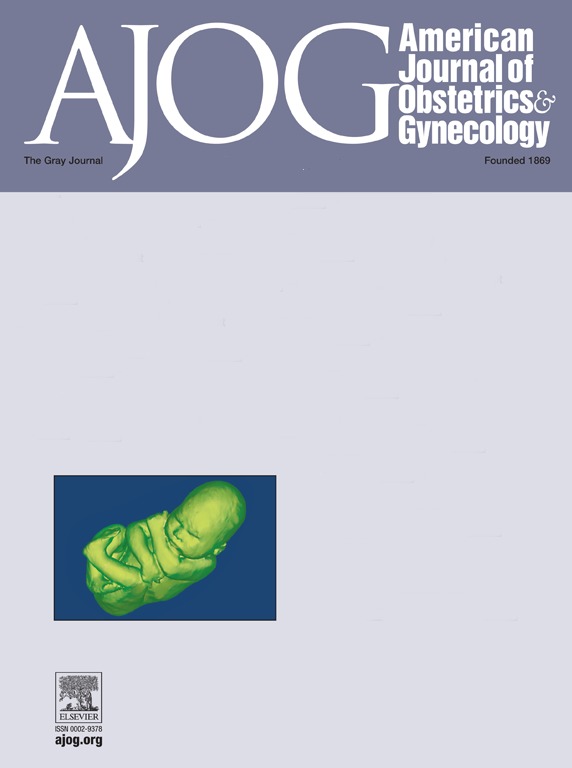Prophylactic oxytocin dose following vaginal birth to prevent postpartum hemorrhage: A systematic review and dose-response meta-analysis.
IF 8.4
1区 医学
Q1 OBSTETRICS & GYNECOLOGY
引用次数: 0
Abstract
OBJECTIVE A systematic review and dose-response meta-analysis assessing the effect of different oxytocin prophylaxis doses on preventing postpartum hemorrhage after vaginal birth. DATA SOURCES MEDLINE, EMBASE, CINAHL, Web of Science, Global Health, CENTRAL and ClinicalTrials.gov (inception - June 9, 2025), along with reference lists of eligible trials. STUDY ELIGIBILITY CRITERIA Randomized controlled trials comparing different intravenous or intramuscular doses of prophylactic oxytocin, or a single prophylactic dose with no oxytocin, following vaginal birth were included. METHODS Two authors independently evaluated studies for inclusion and risk of bias. A random-effects dose-response meta-analysis was conducted using a one-stage approach with a restricted maximum likelihood heterogeneity estimator and modelled using restricted cubic splines to detect departure from linearity. Certainty of evidence was assessed using GRADE methodology. Sufficient data were available to undertake a dose-response meta-analysis for blood loss ≥1000 mL, mean blood loss, blood transfusion, and use of additional uterotonics. RESULTS 13 studies involving 8,961 participants were included, with oxytocin doses ranging from 2.5 and 80 IU. A J-shaped, non-linear relationship was observed for blood loss ≥ 1,000 mL, mean blood loss, and use of additional uterotonics. Doses of 4 to 10 IU resulted in 6 to 7 fewer individuals per 1,000 experiencing blood loss ≥ 1,000 mL (high certainty; risk with no oxytocin: 19 per 1,000 individuals), likely 10 to 12 fewer individuals per 100 requiring additional uterotonics (moderate certainty; risk with no oxytocin: 26 per 100 individuals), but likely resulted in little to no difference in mean blood loss (moderate certainty). Lower doses (2.5-3 IU) likely reduced the risk of severe blood loss (moderate certainty) and may reduce additional uterotonic use (low certainty). At 20 IU, the risk of severe blood loss was probably reduced (moderate certainty), with possible diminishing returns at higher doses (low certainty). Additional uterotonics may increase at doses ≥20 IU (low certainty). No dose-response relationship was observed for blood transfusion. CONCLUSION Available evidence suggests the optimal range for oxytocin prophylaxis after vaginal birth is 4 to10 IU, with lower doses within this range offering the best balance of efficacy and safety. However, limitations in the evidence base, including narrow dose ranges, underrepresentation of high-risk populations, and inconsistent reporting of safety outcomes, highlight the need for further research across clinical contexts.阴道分娩后预防性催产素剂量预防产后出血:一项系统评价和剂量-反应荟萃分析。
目的通过系统评价和剂量-反应荟萃分析,评价不同剂量催产素预防阴道分娩后产后出血的效果。数据来源medline, EMBASE, CINAHL, Web of Science, Global Health, CENTRAL and ClinicalTrials.gov(成立于2025年6月9日),以及符合条件的试验参考列表。研究资格标准:随机对照试验比较阴道分娩后静脉注射或肌肉注射不同剂量的预防性催产素,或单剂量预防性不注射催产素。方法两位作者独立评估了研究的纳入和偏倚风险。随机效应剂量-反应荟萃分析采用单阶段方法,使用受限最大似然异质性估计器,并使用受限三次样条进行建模,以检测偏离线性。使用GRADE方法评估证据的确定性。有足够的数据可用于对失血量≥1000 mL、平均失血量、输血和额外使用子宫强张进行剂量反应荟萃分析。结果纳入13项研究,涉及8,961名受试者,催产素剂量从2.5到80 IU不等。失血量≥1,000 mL、平均失血量与额外使用子宫强张剂呈j型非线性关系。剂量为4至10 IU导致每1000人中失血量≥1000 mL的个体减少6至7人(高确定性;无催产素的风险:每1000人中19人),每100人中需要额外子宫强张的个体可能减少10至12人(中等确定性;无催产素的风险:每100人中26人),但可能导致平均失血量几乎没有差异(中等确定性)。较低剂量(2.5-3 IU)可能降低严重失血的风险(中等确定性),并可能减少额外的子宫扩张使用(低确定性)。在20iu时,严重失血的风险可能会降低(中等确定性),而在较高剂量时可能会减少(低确定性)。当剂量≥20iu时,额外的子宫强直剂可能会增加(低确定性)。输血无剂量-反应关系。结论阴道分娩后预防使用催产素的最佳剂量范围为4 ~ 10 IU,在此范围内较低的剂量可达到疗效和安全性的最佳平衡。然而,证据基础的局限性,包括狭窄的剂量范围,高风险人群的代表性不足,以及安全性结果的不一致报告,突出了在临床背景下进一步研究的必要性。
本文章由计算机程序翻译,如有差异,请以英文原文为准。
求助全文
约1分钟内获得全文
求助全文
来源期刊
CiteScore
15.90
自引率
7.10%
发文量
2237
审稿时长
47 days
期刊介绍:
The American Journal of Obstetrics and Gynecology, known as "The Gray Journal," covers the entire spectrum of Obstetrics and Gynecology. It aims to publish original research (clinical and translational), reviews, opinions, video clips, podcasts, and interviews that contribute to understanding health and disease and have the potential to impact the practice of women's healthcare.
Focus Areas:
Diagnosis, Treatment, Prediction, and Prevention: The journal focuses on research related to the diagnosis, treatment, prediction, and prevention of obstetrical and gynecological disorders.
Biology of Reproduction: AJOG publishes work on the biology of reproduction, including studies on reproductive physiology and mechanisms of obstetrical and gynecological diseases.
Content Types:
Original Research: Clinical and translational research articles.
Reviews: Comprehensive reviews providing insights into various aspects of obstetrics and gynecology.
Opinions: Perspectives and opinions on important topics in the field.
Multimedia Content: Video clips, podcasts, and interviews.
Peer Review Process:
All submissions undergo a rigorous peer review process to ensure quality and relevance to the field of obstetrics and gynecology.

 求助内容:
求助内容: 应助结果提醒方式:
应助结果提醒方式:


